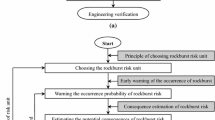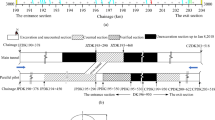Abstract
Early warning of rockbursts remains a worldwide challenge in rock engineering. In this work, a microseismicity-based method of rockburst warning in tunnels is proposed to warn of and reduce the risk of rockburst. The method uses real-time microseismic data and an established rockburst warning formula to provide dynamic warning of rockburst risk during excavation of a tunnel. The establishment of the rockburst warning formula involves several key parts. These include a rockburst database, selection of typical rockburst cases, functional relationships between microseismicity and rockbursts, optimal weighting coefficients, and dynamic updating. By using the proposed method, the probability of strain and strain-structure slip rockbursts of different intensity (extremely intense, intense, moderate, slight, and none) can be warned of in real time. The method has been successfully applied to rockburst warning in deeply buried tunnels at the Jinping II hydropower project (about 11.6 km in total for D & B tunnels). This success illustrates the applicability of the proposed method. In addition, it is found that during the rockburst development process, the microseismic eigenvalues for strainbursts are bigger than in strain-structure slip rockbursts of the same intensity.















Similar content being viewed by others
References
Amidzic D, Murphy SK, van Aswegen G (1999) Case study of a large seismic event at a South African gold mine. In :9th international congress on rock mechanics, ISRM, Paris. pp 1033-1038
Andrzej L, Zbigniew I (2009) Space-time clustering of seismic events and hazard assessment in the Zabrze-Bielszowice coal mine, Poland. Int J Rock Mech Min Sci 46:918–928
Becka DA, Brady BHG (2002) Evaluation and application of controlling parameters for seismic events in hard-rock mines. Int J Rock Mech Min Sci 39:633–642
Cai M, Kaiser PK, Martin CD (2001) Quantification of rock mass damage in underground excavations from microseismic event monitoring. Int J Rock Mech Min Sci 38:1135–1145
Cai M, Morioka H, Kaiser PK et al (2007) Back-analysis of rock mass strength parameters using AE monitoring data. Int J Rock Mech Min Sci 44:538–549
Everitt BS, Landau S, Leese M (2001) Cluster analysis. Oxford University Press, NewYork
Feng XT, Chen BR, Li SJ et al (2012a) Study on the evolution process of rockbursts in deep tunnels. J Rock Mech Geo Eng 4(4):289–295
Feng XT, Chen BR, Ming HJ et al (2012b) Evolution law and mechanism of rockbursts at deep tunnels: immediate rockburst. Chin J Rock Mech Eng 31(3):433–444 (in Chinese)
Feng GL, Feng XT, Zhao ZN et al (2013a). Rockburst risk analysis based on MS monitoring in deep-buried tunnel with TBM excavation. In: 3rd ISRM Symposium on Rock Characterisation, Modelling and Engineering Design Methods, SINOROCK, June 18-June 20, Shanghai, China. pp 793–98
Feng XT, Chen BR, Zhang CQ et al (2013b) Mechanism, warning and dynamic control of rockburst development processes. Science Press, Beijing (in Chinese)
Feng GL, Feng XT, Chen BR et al (2015) Sectional velocity model for microseismic source location in tunnels. Tunn Underg Sp Tech 45:73–83
Ge MC (2005) Efficient mine MS monitoring. Int J Coal Geol 64:44–56
Hedley DGF (1992) Rockburst handbook for Ontario hardrock mines. CANMET SP92-1E
Heinz H, Rolf S, Stephan H (2008) Gotthard base tunnel rock burst phenomena in a fault zone, measuring and modelling results. In: World Tunnel Congress 2008—Underground Facilities for Better Environment and Safety, India. pp 419–430
Hirata A, Kameokay Y, Hirano T (2007) Safety management based on detection of possible rockbursts by AE monitoring during tunnel excavation. Rock Mech Rock Eng 40(6):563–576
Kaiser PK (2009) Seismic hazard evaluation in underground construction. In: Proceedings of Seventh International Symposium on Rock burst and Seismicity in Mines, 20–23 August, Dalian, China. pp 1–26
Kaiser PK, Cai M (2012) Design of rock support system under rockburst condition. Chin J Rock Mech Eng 04(3):215–227
Kaiser PK, Tannant DD, McCreath DR (1996) Canadian rockburst support handbook. Geomechanics Research Centre/Laurentian University, Sudbury/Ontario
Kaiser PK, Vasak P, Suorineni FT et al (2005) New dimensions in seismic data interpretation with 3-D virtual reality visualization in burst-prone ground. Ra-Sim6, Perth, Australia, pp 33–47
Kennedy J, Eberhart RC (1995) Particle Swarm Optimization. In: International Conference on Neural Networks. IEEE Press, Piscataway 1942–1948
Li T, Cai MF, Cai M (2007) A review of mining-induced seismicity in China. Int J Rock Mech Min Sci 44:1149–1171
Liu JP, Feng XT, Li YH et al (2013) Studies on temporal and spatial variation of MS activities in a deep metal mine. Int J Rock Mech Min Sci 60:171–179
Mccreary R, Mcgaughey J, Potvin Y et al (1992) Results from MS monitoring, conventional instrumentation, and tomography surveys in the creation and thinning of a burst-prone sill pillar. Pure appl Geophys 139:349–373
Mendecki AJ (1993) Keynote address: Real time quantitative seismology in mines. In: Proceedings of Third International Symposium on Rock- bursts and Seismicity in Mines 16–18 August 1993. Kingston, Ontario, Canada. pp 287–295
Mendecki AJ (1996) Seismic monitoring in mines. Chapman & Hall, London
Newland A, Campbell R, Macdonald C (2003) The development and implementation of the Moonee Colliery windblast warning and control system. In: 1st Australansian Ground Control in Mining Conference, 10–13, November. pp 33–43
Ortlepp WD (1997) Rock fracture and rockbursts-an illustrative study. J S Afr I Min Metall, Johannesburg
Ortlepp WD, Stacey TR (1994) Rockburst mechanisms in tunnels and shafts. Tunn Undergr Sp Tech 9(1):59–65
Poplawski RF (1997) Seismic parameters and rockburst hazard at Mt Charlotte mine. Int J Rock Mech Min Sci 34(8):1213–1228
Shan Z, Yan P (2010) Management of rock bursts during excavation of the deep tunnels in Jinping II Hydropower Station. B Eng Geol Environ 69:353–363
Tan YA (1989) Analysis of fractured face of rockburst with scanning electron microscope and its progressive failure process. J Chin Electron Microsc Soc 2:41–48 (in Chinese)
Trifu CI, Suorineni FT (2009) Use of MS monitoring for rockburst management at VALE INCO mines. In: Proceedings of Seventh International Symposium on Rock burst and Seismicity in Mines, 20–23 August 2009, Dalian, China. pp. 1105–1114
Urbancic TI, Trifu CI (2000) Recent advances in seismic monitoring technology at Canadian mines. J Appl Geophys 45:225–237
Van Aswegen G, Butler AG (1993) Applications of quantitative seismology in South Africa gold mines. In: Proceedings of Third International Symposium on Rockbursts and Seismicity in Mines, 16–18 August 1993. Kingston, Ontario, Canada. pp. 261–266
Zhang CQ, Feng XT, Zhou H (2012) A top pilot tunnel preconditioning method for the prevention of extremely intense rockbursts in deep tunnels excavated by TBMs. Rock Mech Rock Eng 45:289–309
Zhao ZN, Feng XT, Chen BR et al (2013) Study of relativity between rockburst and MS activity zone in deep tunnel. Rock Soil Mech 34(2):491–497 (in Chinese)
Zimmermann HJ (1987) Fuzzy sets, decision making and expert systems. Kluwer Academic Publishers, Boston
Acknowledgments
The authors gratefully acknowledge financial support from the National Natural Science Foundation of China (grant no. 11232014). The authors would also like to thank Professors Zhou Hui, Wu Shiyong, Wang Jimin, and Zeng Xionghui, and Dr. Zhao Zhouneng, Chen Dongfang and Mr Li Qingpeng who give support and assistance during microseismicity monitoring in the headrace and drainage tunnels in the Jinping II hydropower station project.
Author information
Authors and Affiliations
Corresponding author
Rights and permissions
About this article
Cite this article
Feng, GL., Feng, XT., Chen, Br. et al. A Microseismic Method for Dynamic Warning of Rockburst Development Processes in Tunnels. Rock Mech Rock Eng 48, 2061–2076 (2015). https://doi.org/10.1007/s00603-014-0689-3
Received:
Accepted:
Published:
Issue Date:
DOI: https://doi.org/10.1007/s00603-014-0689-3




